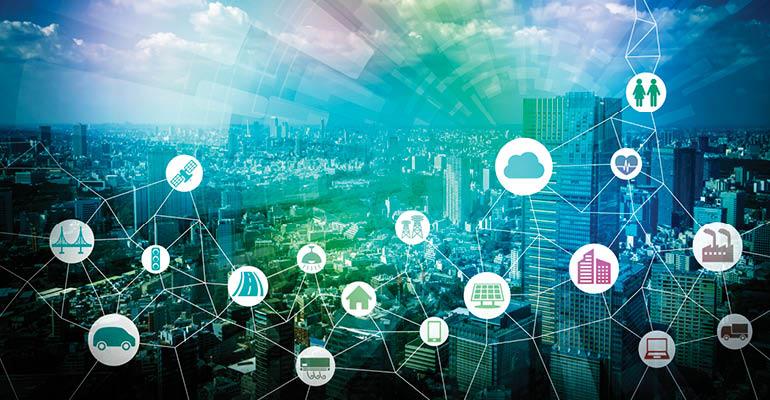The pace of technology innovations in real estate is accelerating, according to Andrea Chegut, Ph.D., director with the Massachusetts Institute of Technology’s Real Estate Innovation Lab and head of research with the MIT Center for Real Estate.
The MIT lab is exploring the future of the built environment and how design and technology will affect the way humans live, work and play. The lab has two research projects underway. One involves the development of a geometric, geospatial relational database of Manhattan that includes rents, transaction prices, building mortgages, co-working spaces, cell towers, fiber optic cables, subway lines and more. Chegut notes that datasets like that will make it easier to understand the industry’s future.
But the team is also developing Real Estate Innovation Life Cycle, a visualization of real estate product innovations and how they change over time. This product will be used as an industry framework for tracking and harnessing innovation impacts. She notes that this will help prepare buildings for a physical transition every five to 10 years as newly developed technology is adopted.
Benjamin Breslau, managing director, Americas research, at real estate services firm JLL, which is a founding partner of the MIT lab, says that investors should consider technology that (1) automates and helps them run their business more efficiently; (2) impacts the size of tenant spaces and future-proofs buildings throughout their lifecycle; and (3) collects data for analytics useful in running buildings efficiently.
A summary of technologies on the horizon that are likely to have a significant impact on real estate investment follows.
Blockchain, a digital ledger of economic transaction data that is validated by an entire network of computers, can be programmed to record financial transactions and virtually everything of value. This technology is relevant for processing real estate transactions and should be quickly adopted by the commercial real estate industry, according to Brandon Nunnink, managing director for valuation and advisory services in the Midwest with real estate services firm JLL.
Artificial intelligence (AI) will collect data that improves information transparency and helps investors make better decisions by providing access to specific data, such as building energy consumption, market rates and how tenants utilize workspace and common areas, says Breslau. Greater transparency should also increase competition for assets because more investors will have access to the same information, he adds. “The key may no longer be who has the data, but more who knows how to interpret it and apply insights.”
Breslau brings up Skyline AI, a proprietary artificial intelligence and machine learning platform that JLL has invested in through its JLL Spark arm. Skyline automates asset valuation and underwriting. JLL Spark made the decision to invest in the start-up because it leverages industry data from more than 130 different sources and analyzes more than 10,000 attributes of each asset for the last 50 years to predict future performance and accurately estimate asset value.
Currently in the testing phase, autonomous vehicles are expected to have the greatest impact on the urban landscape and future building uses. Developers are already adding drop-off platforms to building infrastructure to accommodate services like Uber and Lyft. However, according to Breslau, “We’re advising developers to future-proof projects by preparing for a building’s future lifecycle in the planning and design stage.”
Rather than building a ramp system in parking structures, for instance, some development companies are incorporating flexibility into projects that allows parking structures to be repositioned for other uses, like apartments, gyms, common areas, self-storage or urban “last mile” logistics facilities, Breslau says.
Full adoption of the autonomous car will require a major shift in human behavior, stresses Jeff Berman, a partner at venture capital Camber Creek, which is focused on funding companies that advance technology for real estate.
Initially, office workers will likely both own their own vehicles and use autonomous cars like a taxi service, so parking space will still be required, just not as much, he says. Berman suggests that with a 100-year history of car ownership, some people will still want a car, but may put their vehicles into autonomous vehicle fleets to earn money while they are at work.
Autonomous cars will also likely change where people live and work and where transit hubs are located, in addition to impacting future development of public transit infrastructure. Berman notes that the need for less parking will provide investors with opportunities for new development and redevelopment on sites now occupied by parking lots and parking structures. The availability of more infill sites would, therefore, increase urban density as multifamily projects replace parking space and provide space for other commercial uses.
The Internet of Things (IoT), which is powering smart city technology, also offers significant opportunities for investing in connectivity and sensors that control city and development infrastructure, as well as the computing power that collects and analyzes data, says Breslau. Data collected by IoT could be useful to real estate planning and investment, he notes.
“It will be imperative for cities and companies to develop digital master plans to determine how IoT and sensor technology can improve infrastructure, safety, emergency response and sustainability initiatives,” Breslau says. “But they also need sufficient computing power to collect and analyze data and a plan for how it will be utilized. This is area where many cities and companies are falling short.”





